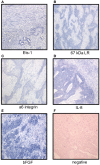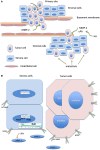The role of the tumor stroma in ovarian cancer
- PMID: 24860785
- PMCID: PMC4026708
- DOI: 10.3389/fonc.2014.00104
The role of the tumor stroma in ovarian cancer
Abstract
The tumor microenvironment, consisting of stromal myofibroblasts, endothelial cells, and leukocytes, is growingly perceived to be a major contributor to the pathogenesis and disease progression in practically all cancer types. Stromal myofibroblasts produce angiogenic factors, proteases, growth factors, immune response-modulating proteins, anti-apoptotic proteins, and signaling molecules, and express surface receptors and respond to stimuli initiated in the tumor cells to establish a bi-directional communication network in the microenvironment to promote tumor cell invasion and metastasis. Many of these molecules are candidates for targeted therapy and the cancer stroma has been recently regarded as target for biological intervention. This review provides an overview of the biology and clinical role of the stroma in ovarian cancer.
Keywords: metastasis; ovarian carcinoma; prognosis; stromal myofibroblasts; tumor progression.
Figures


Similar articles
-
Tumor microenvironment: The culprit for ovarian cancer metastasis?Cancer Lett. 2016 Jul 28;377(2):174-82. doi: 10.1016/j.canlet.2016.04.038. Epub 2016 Apr 27. Cancer Lett. 2016. PMID: 27131957 Review.
-
Molecular insights into prostate cancer progression: the missing link of tumor microenvironment.J Urol. 2005 Jan;173(1):10-20. doi: 10.1097/01.ju.0000141582.15218.10. J Urol. 2005. PMID: 15592017 Review.
-
Emerging roles of the tumor-associated stroma in promoting tumor metastasis.Cell Adh Migr. 2012 May-Jun;6(3):193-202. doi: 10.4161/cam.20631. Epub 2012 May 1. Cell Adh Migr. 2012. PMID: 22568980 Free PMC article. Review.
-
The autophagic tumor stroma model of cancer or "battery-operated tumor growth": A simple solution to the autophagy paradox.Cell Cycle. 2010 Nov 1;9(21):4297-306. doi: 10.4161/cc.9.21.13817. Epub 2010 Nov 30. Cell Cycle. 2010. PMID: 21051947 Free PMC article. Review.
-
Tumor stroma-derived factors skew monocyte to dendritic cell differentiation toward a suppressive CD14+ PD-L1+ phenotype in prostate cancer.Oncoimmunology. 2014 Dec 13;3(9):e955331. doi: 10.4161/21624011.2014.955331. eCollection 2014 Oct. Oncoimmunology. 2014. PMID: 25941611 Free PMC article.
Cited by
-
Computational tumor stroma reaction evaluation led to novel prognosis-associated fibrosis and molecular signature discoveries in high-grade serous ovarian carcinoma.Front Med (Lausanne). 2022 Sep 7;9:994467. doi: 10.3389/fmed.2022.994467. eCollection 2022. Front Med (Lausanne). 2022. PMID: 36160147 Free PMC article.
-
Identification of grade and origin specific cell populations in serous epithelial ovarian cancer by single cell RNA-seq.PLoS One. 2018 Nov 1;13(11):e0206785. doi: 10.1371/journal.pone.0206785. eCollection 2018. PLoS One. 2018. PMID: 30383866 Free PMC article.
-
miR200-regulated CXCL12β promotes fibroblast heterogeneity and immunosuppression in ovarian cancers.Nat Commun. 2018 Mar 13;9(1):1056. doi: 10.1038/s41467-018-03348-z. Nat Commun. 2018. PMID: 29535360 Free PMC article.
-
Ovarian Cancer Cell-Conditioning Medium Induces Cancer-Associated Fibroblast Phenoconversion through Glucose-Dependent Inhibition of Autophagy.Int J Mol Sci. 2024 May 23;25(11):5691. doi: 10.3390/ijms25115691. Int J Mol Sci. 2024. PMID: 38891879 Free PMC article.
-
Class I histone deacetylase inhibition promotes CD8 T cell activation in ovarian cancer.Cancer Med. 2021 Jan;10(2):709-717. doi: 10.1002/cam4.3337. Epub 2020 Dec 24. Cancer Med. 2021. PMID: 33369199 Free PMC article.
References
Publication types
LinkOut - more resources
Full Text Sources
Other Literature Sources

